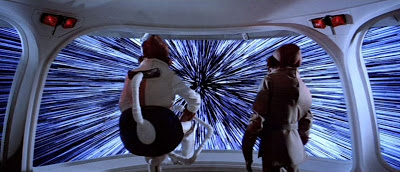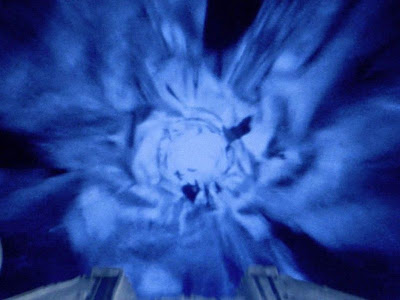Hyperspace is the alternate state of existence used by starships to achieve faster-than-light travel. It was a phenomenon not completely understood by scientists; it was alternately described as a parallel universe, an extra dimension of space, an alternate mode of physical existence, or simply the universe as viewed traveling faster than the speed of light.
To hyperspace was also a verb in Basic, as in phrases like “You are required to hyperspace back to the fleet when you complete the mission.”
Technical background
Normally, baryonic matter obeys physical principles of relativity: they increase exponentially in mass as they approach the speed of light, requiring more and more energy to approach it, and thus always remain below this threshold. Tachyonic matter, on the other hand, existed solely above the speed of light, and could not pass below said threshold. Hyperdrive technology allowed sentients to break this barrier and allowed slower-than-light starships to leap past the barrier and reach speeds many thousands or millions of times that of light.
History
This principle was first discovered by the ancient Rakata, some time around 50,000 BBY. The Rakatan Force-enabled drives allowed them to create a galaxy-spanning empire. Some of the earliest hyperspace-utilizing artifacts (such as strange arches and matter transmitters found on ruined worlds, or the Gree hypergates), cannot be replicated by modern hyperdrive technology. Corellians and Duros were the earliest able to create technological versions of the Force-enhanced Rakatan devices through reverse engineering, allowing them to build the first true hyperdrives. Consequently, despite common usage, relatively little is known about the true nature of hyperspace. Popular theories say that hyperspace utilizes another dimension to ‘sidestep,’ as it were, the light ‘speed limit.’ Others theorize that it phases matter directly into another universe, similar to otherspace or subspace, and thus gain superlight speeds. Whatever the case, there were many complex scientific principles known to modern hyperdrive engineers which allowed for a myriad different uses of this faster-than-light phenomenon.
For the first 21,000 years of the Old Republic, hyperspace coordinates were plotted with the aid of hyperspace beacons, space stations placed in open space, distant from gravity wells, where ships would download data provided by the Republic Spacelanes Bureau. Around the time of the Mandalorian Wars, navicomps replaced the beacons, making hyperspace navigation much more autonomous.
Hyperdrive usage
A starship utilizing a hyperdrive had to go through a fixed, routine process. After the course was plotted in the navigation computer, the ship moved to the bearing matching that course and activated the hyperdrive. The ship then accelerated so rapidly that the passengers within the vessel seemed to see the stars stretched into parallel lines when they made the ‘jump’ to hyperspace. The fact of the acceleration was also observable from outside the vessel, where a ship jumping to hyperspace would appear to undergo a sudden, massive burst of speed and disappear from the physical universe.
When entering hyperspace, the starship left conventional existence, or realspace. This phenomenon, known as pseudomotion, occurred as the massive acceleration results in a motion which rendered conventional notions of velocity irrelevant. At hyperspeed, the entire universe is compacted into a blue-shaded ‘tunnel’ of high-speed blur, effectively cutting off the ship from the normal methods of scanning and detection.
Hyperdriving of a ship was done by submitting coordinates to a navicomputer, either manually or by being received by wireless transmissions; Rogue Squadron, among many others, used this kind of transmission so that everyone had the same coordinates during a mission. Coordinate calculation was a somewhat dangerous task, for if someone in hyperspace approached too close to a black hole or star, they would be jolted out of hyperspace because of their gravitational attraction. Intrasystem hyperdriving was quite uncommon, but was sometimes used strategically to surprise an enemy.
Because hyperspatial navigation was difficult, routes often traveled were close to inhabited systems. In the event of a problem, the possibility of communicating with a nearby planet could be a great help in a difficult situation. Such problems were usually mistakes in calculating the coordinates or either not having very new data—such as of dead or newly-formed stars—included in old databases. Trying to find a ship that had re-entered realspace at the wrong location was a nearly impossible task, as the many who sought the legendary Katana Fleet learned.
Hazards
When moving at speeds many times the speed of light, there were many dangers. While any collision or interference at this state can be potentially fatal, the effects of gravitational pull on a starship could be particularly devastating, thus a course had to be plotted outside the “mass shadow” or gravity well of large celestial bodies. This was exploited in many ways through the ages. Hyperspace courses were often plotted using a planet’s mass as a backstop, with the hyperdrive’s safety systems automatically stopping the ship as it reached the farthest point of possible travel.
Gravity generators could be used to create an artificial interdiction field which stopped hyperspace travel in a particular area by mimicking the outer fringes of a celestial body’s gravity, useful for both pulling ships out of hyperspace en route and preventing enemies from escaping to lightspeed during engagement. Less affluent groups, such as pirates, dragged large asteroids (or planetoids) into trade routes in lieu of the generator or starship method, providing them with both a means to stop shipping and a temporary base or shield against hostile fire.
Black holes were a constant menace. At least a few vessels each year were destroyed by the several “wandering” black holes in real space. Their near infinite gravity wells could be catastrophic to craft that passed too close.
Outside the bounds of a vessel’s shielding, hyperspace itself was a lethal environment to any realspace species. Being blown out of the airlock of a vessel while in hyperspace was a more effective way to kill an individual than exposing that individual to the vacuum of realspace. An individual could survive in an escape pod ejected in hyperspace, but if the pod lacked a hyperdrive of its own, reversion to realspace would be impossible.
Even staring at hyperspace from the observation deck of a starship for a prolonged amount of time could produce “hyper-rapture”, a form of madness, in a being, or so the legends stated. As there was something fundamentally wrong with viewing the higher-dimensional universe, standard Imperial operating procedure was to keep the transparisteel opaqued during travel through hyperspace. However, Darth Vader enjoyed staring at the kaleidoscopic and swirling patterns of light, and Cronal found it soothing to stare into what he thought of as the emptiness outside the universe.
Effects on sensors and comms
In addition to navigational hazards, there was also the difficulty inherent in communicating with a starship while traveling at hyperspeed. Since ships in hyperspace did not exist, in a conventional sense, they were largely cut off from conventional radio or subspace communication, since wavelengths of any signal would be massively distorted even if they reached the vessel. Hypercomm signals could reach a vessel in hyperspace, however it was very difficult to communicate in even this fashion unless the signal was sent from one end or the other of the traveling ship’s course, or between ships on the same course.
The same difficulties presented to communication also applied to sensors; it was nearly impossible to maintain sensor lock on a vessel in hyperspace, which made escape to lightspeed a very robust retreat option in most engagements. The only option available for pursuit was generally to plot several courses along the target’s last known vector, and try to guess where the ship would come out of hyperspace for course corrections. This was generally a losing strategy, of course, since most ships wishing to avoid pursuit would plot a short jump, followed by a longer one to the destination at a different vector before enemies could arrive. The best option was to place a homing beacon on the enemy ship, but at large distances only HoloNet-equipped tracking devices were useful, and these were fantastically expensive.
An interesting phenomenon associated with hyperspace travel was Cronau radiation. This was a short, but powerful burst of radiation which was generated when a ship entered and left hyperspace. It could be detected by properly aligned sensors from a few light-seconds away, often well outside normal sensor radius. This was how the Rebel base on Hoth was able to prepare for the oncoming attack when Admiral Ozzel mistakenly took the Executor and its battle fleet out of hyperspace too close to the system, rather than approaching stealthily from outside the system.
Communications
While hyperspace travel was the primary usage of this phenomenon which bound the modern galaxy together, it was by no means the only one. Hypercomm technology sent signal packets through hyperspace at greater speeds and distances than was possible with more conventional subspace transmitters, and this was done so with much greater speed than hyperdrive-equipped starships. The HoloNet increased the range still further, using an interconnected network of hyperspace beacons to rebroadcast enormous tracts of data over the entire galaxy, allowing instantaneous, full-holo transmissions from virtually any subscriber to any other. Under the Galactic Empire, the HoloNet was rigorously controlled, and even under the New Republic, the network was fantastically expensive to maintain, and so direct two-way connection was usually limited to government personnel and the wealthy. News, entertainment, and other wide-reaching broadcasts were transmitted throughout the galaxy and repeated on local sector-based subspace networks, however, so every level of galactic society was touched by this communications tool, not simply those with expensive hypercomm systems.
Navigation
Because of the danger of mass shadows (not to mention interdicting pirates), hyperspace courses had to be plotted with great caution. Very few beings other than powerful Jedi could react while traveling at many times the speed of light, and in any case conventional sensors and communicators could not receive information faster than lightspeed. Even subspace sensors, which operated along an alternate dimension and propogate faster than light, could not keep up with the vast speeds of hyperspace travel. Thus, precise advance knowledge of the celestial bodies along the way was necessary in the form of navigational computers. These devices, also known as nav comps or navicomputers by spacers, contained detailed star charts and the ability to make astronavigational calculations quickly from one point to another before a jump was taken.
While pilots had to have a basic understanding of astronav skills to operate a nav computer proficiently, they didn’t need to know the complex physical equations necessary for hyperspeed travel, although some species, such as the Givin and Siniteen, were able to calculate these equations in their heads and thus did not require the help of a computer. The internal library charts had to be periodically updated, of course, as systems move slowly around the galaxy, stars explode and are born, and so on, and so a dedicated explorer and cartographer corps still existed millennia after the first star lanes were plotted.
Most star travelers used preexisting, well-known trade routes. This guaranteed that interdiction by pirates and celestial bodies was kept to a minimum, help was close by in the case of a malfunction, and travel times could be reasonably predicted.
Hyperspace travel times
While generally determined by the distance between two planets, hyperspace travel times between two locations seemingly close to one another could be drastically extended by the need to navigate around stellar hazards, such as asteroid fields and nebulae.
An example of this is the journey from Coruscant and Alderaan. In terms of distance, Alderaan was very near to Coruscant. However, it required 16 hours of travel to reach Alderaan due to a section of the route crossing through a part of the largely-uncharted Deep Core which is star-choked and therefore more difficult to navigate in due to its many gravity wells. Ironically, then, it was actually faster to get from Tatooine to Alderaan on the other side of the galaxy. In some cases, intragalactic travels could take days, depending on the distance between two planets and the obstacles between











Comments are closed.